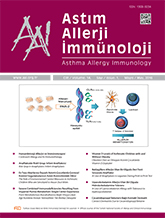


Objective: The infantile group that is accepted to be at risk of anaphylaxis has a special importance since they are unable to express their complaints and also the signs and symptoms of anaphylaxis can be confused with common symptoms of infants such as drooling, vomiting, diarrhea and itching. However, early detection of the signs and symptoms of anaphylaxis is crucial for effective diagnosis and treatment. The aim of study was to draw attention to infants anaphylaxis.
Materials and Methods: All of the patients in the infant group (n=15) among a total of 35 anaphylaxis cases that we followed in the Pediatric Allergy Clinic of Dr. Behçet Uz Children`s Hospital between the years 2011-2015 were included in the study. Demographic and clinical features of the patients were evaluated.
Results: 9 of 15 (60%) patients involved in the study were male and 6 (40%) were female, and the average age of anaphylaxis was 8.13±6.83 (min 1-max 24) months. In 93% of cases (n=14) the trigger was food and in 7% of cases (n=1) the trigger was not determined. The most frequently responsible foods were respectively cow`s milk (67%) and egg (20%). In 7 patients (47%), there were respiratory system and skin manifestations, in 7 patients (47%) 3 system involvement and in 1 patient respiratory and gastrointestinal system involvement has been observed. In only 3 cases (20%) the blood pressure was measured and also epinephrine was administered to only 3 cases (20%) in the hospital. In only 3 of the patients (20%), an epinephrine injector was prescribed after anaphylaxis.
Conclusion: It was detected that the most common triggers are cow`s milk and egg, the subjective symptoms are frequently overlooked, an atopic nature is a risk factor and physicians` rates of blood pressure measurement, epinephrine administration and EpiPen autoinjector prescription are low.